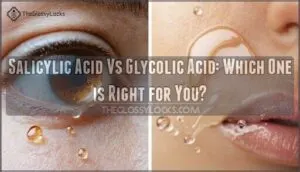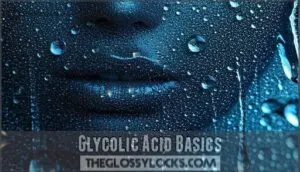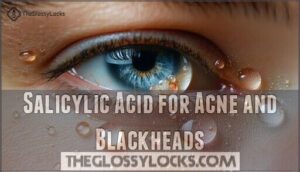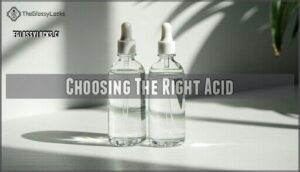This site is supported by our readers. We may earn a commission, at no cost to you, if you purchase through links.

Salicylic acid is oil-soluble and penetrates deep into your pores, making it perfect for tackling acne, blackheads, and oily skin.
Glycolic acid is water-soluble and works on your skin’s surface, effectively removing dead cells to reveal brighter skin while reducing fine lines and dark spots.
Think of salicylic acid as your pore-clearing specialist, while glycolic acid is your surface-smoothing expert.
Your skin type determines the winner – oily, acne-prone skin loves salicylic acid, while dry or aging skin benefits more from glycolic acid’s brightening power.
Table Of Contents
- Key Takeaways
- Salicylic Acid Basics
- Glycolic Acid Basics
- Exfoliation Methods
- Skin Concerns Targeted
- Skin Type Suitability
- Benefits and Effects
- Potential Side Effects
- Combining Acids
- Choosing The Right Acid
- Frequently Asked Questions (FAQs)
- Is salicylic acid better than glycolic acid?
- Can I use salicylic acid and glycolic acid together?
- Is glycolic acid or salicylic acid better for feet?
- Is glycolic acid or salicylic acid better for scalp?
- Which is better, glycolic or salicylic acid?
- Can I use glycolic acid and salicylic acid together?
- Should I use glycolic or salicylic acid at night?
- How do glycolic and salicylic acids affect skin pH?
- Can pregnant women safely use these acids?
- Do glycolic and salicylic acids have shelf lives?
- Conclusion
Key Takeaways
- You’ll get better results with salicylic acid if you have oily, acne-prone skin – its oil-soluble nature penetrates deep into pores to dissolve excess sebum and clear blackheads where glycolic acid can’t reach.
- Choose glycolic acid for anti-aging and brightening concerns – this water-soluble AHA works on your skin’s surface to smooth fine lines, fade dark spots, and boost collagen production for younger-looking skin.
- You can use both acids together, but start slowly – apply salicylic acid in the morning and glycolic acid at night, or alternate days to prevent over-exfoliation while maximizing their complementary benefits.
- Your skin type determines which acid works best – dry or sensitive skin typically responds better to glycolic acid’s gentler approach, while oily skin thrives with salicylic acid’s deep pore-clearing abilities.
Salicylic Acid Basics
Salicylic acid is a beta-hydroxy acid (BHA) derived from willow bark that works differently than other skincare acids because it’s oil-soluble.
This unique property allows it to penetrate deep into your pores, where it dissolves excess oil and dead skin cells that cause acne and blackheads.
Chemical Properties
When diving into skincare acids, you’ll encounter two distinct chemical families.
Salicylic acid belongs to the beta hydroxy acid (BHA) group, making it oil-soluble and perfect for penetrating sebaceous glands.
This chemical exfoliant differs fundamentally from alpha hydroxy acid (AHA) cousins like glycolic acid, which remain water-soluble.
Understanding this AHA vs BHA distinction helps you choose wisely for your skin’s needs.
Origins and Derivatives
Understanding where salicylic acid comes from helps you appreciate its skincare power.
This beta hydroxy acid BHA has diverse natural sources and extraction methods:
- Willow bark – the original natural source used for centuries
- Wintergreen leaves – contains methyl salicylate compounds
- Sweet birch – another traditional botanical source
- Meadowsweet flowers – provides salicylates easily converted to salicylic acid
- Lab synthesis – modern production from phenylalanine or phenol
Natural sources versus lab synthesis both deliver effective exfoliating acids.
Its chemical formula is C7H6O3.
Oil-Soluble Benefits
Salicylic acid’s oil-soluble nature gives it a unique advantage over glycolic acid.
Salicylic acid cuts through oil like a master key, unlocking clogged pores where water-based acids simply can’t reach.
This BHA exfoliant cuts through sebum like a key opening stubborn doors, enabling deep pore penetration that water-based acids can’t achieve.
You’ll find it excels at sebum dissolving, blackhead reduction, and oil regulation, making it the go-to acne treatment for controlling breakouts from within your pores.
Glycolic Acid Basics
Glycolic acid is an alpha hydroxy acid (AHA) derived from sugar cane that works as a water-soluble exfoliant on your skin’s surface.
You’ll find this smallest AHA molecule effectively removes dead skin cells and promotes cell turnover to reveal brighter, smoother skin underneath.
Natural Sources
Glycolic acid comes from nature’s sweetest sources, making it a favorite among natural skincare ingredients.
Unlike salicylic acid’s tree bark origins, this AHA exfoliant emerges from various plant sources through different extraction methods.
Here are glycolic acid’s primary natural sources:
- Sugarcane – The most common source for commercial production
- Citrus fruits – Lemons and oranges contain natural concentrations
- Sugar beets – An alternative plant origin for sustainable sourcing
- Pineapples – Traditional uses include natural fruit peels
These source variations affect potency and purity in skincare formulations. For enhanced hydration, consider using shea butter effects alongside glycolic acid.
Water-Soluble Benefits
Water-soluble properties give glycolic acid its unique advantage as an AHA exfoliant.
This characteristic allows it to work effectively on your skin’s surface, delivering a hydration boost while performing surface exfoliation.
Unlike oil-based treatments, glycolic acid’s water-soluble nature means it won’t clog pores, making it suitable for sensitive skin types.
Its gentle action helps achieve an even tone by removing dead cells without the deep penetration that salicylic acid provides, making glycolic acid ideal for brightening and smoothing your complexion.
Exfoliation Methods
You’ll find that glycolic acid works on your skin’s surface to dissolve dead cells and reveal smoother skin underneath.
While salicylic acid penetrates deep into your pores to clear out oil and debris.
These two acids use completely different approaches to exfoliation, making your choice depend on whether you need surface renewal or deep pore cleaning.
Glycolic Acid Surface Exfoliation
When you apply glycolic acid, this alpha hydroxy acid (AHA) works its magic on your skin’s surface through a gentle chemical peel process.
The surface exfoliation process dissolves bonds between dead skin cells, accelerating cell turnover and revealing fresh skin underneath.
This skin resurfacing creates immediate brightening effects, making your complexion look more radiant and smooth after each application.
To avoid irritation, it’s essential to keep in mind lower concentration levels for sensitive skin.
Salicylic Acid Deep Pore Exfoliation
Unlike surface-level treatments, salicylic acid works like a key opening your pores from within.
This BHA exfoliant penetrates oil-based blockages where other acids can’t reach, making it your go-to solution for stubborn skin issues.
Here’s what deep pore cleansing delivers:
- Blackhead Dissolving – Breaks down stubborn clogs at their source
- Sebum Production Control – Regulates excess oil without over-drying
- Pore Size Reduction – Minimizes appearance through thorough cleaning
- Acne Prevention – Stops breakouts before they start with deep cleanse benefits
Comparison of Exfoliation Techniques
Both acids work differently due to their molecular size and penetration abilities.
Glycolic acid, an alpha hydroxy acid AHA, stays surface-level as a chemical exfoliant, boosting skin cell turnover through shallow acid penetration.
Salicylic acid, a beta hydroxy acid BHA, dives deeper with superior exfoliation depth, targeting sebum dissolving within pores for thorough cleansing.
Glycolic acid also promotes collagen production for improved skin elasticity.
Skin Concerns Targeted
You’ll find that glycolic acid excels at tackling signs of aging, dark spots, and uneven skin texture through surface exfoliation.
Salicylic acid targets acne, blackheads, and excess oil by working deep within your pores to clear clogs and reduce breakouts.
Glycolic Acid for Aging and Hyperpigmentation
Glycolic acid excels at tackling signs of aging and uneven skin tone.
As the smallest alpha hydroxy acid (AHA), it penetrates effectively to address multiple concerns:
- Wrinkle Reduction – Stimulates collagen boost for smoother skin
- Dark Spot Fading – Targets hyperpigmentation from sun damage
- Texture Improvement – Removes dead cells for refined surface
- Skin Brightening – Reveals fresh, radiant complexion underneath
Consistent use of exfoliants helps with maintaining consistent results.
Salicylic Acid for Acne and Blackheads
Salicylic acid’s oil-soluble nature makes it your go-to beta hydroxy acid BHA for tackling acne and blackheads head-on.
This powerhouse penetrates deep into pores, dissolving excess sebum and dead skin cells that cause blackhead formation.
It reduces pore size appearance while providing inflammation reduction around breakouts.
Explore products with salicylic acid for effective treatment.
For oily skin struggling with acne severity, salicylic acid offers targeted sebum control.
Overlapping Benefits and Differences
Both salicylic acid and glycolic acid share remarkable exfoliation benefits, yet they tackle skin concerns through different pathways.
These powerhouse ingredients overlap in brightening potential and texture improvement, making your choice easier than you’d think.
- Shared Exfoliation: Both alpha hydroxy acid (AHA) and beta hydroxy acid (BHA) remove dead skin cells effectively
- Brightening Potential: Each acid reveals fresher, more radiant skin underneath
- Texture Improvement: Both smooth rough patches and refine skin surface
- Hyperpigmentation Overlap: Both acids help fade dark spots and even skin tone
- Anti-inflammatory Properties: Each ingredient calms irritated skin while exfoliating
Skin Type Suitability
Your skin type determines which acid will work best for your specific needs and concerns.
Glycolic acid suits dry and sensitive skin types that need hydration and anti-aging benefits.
While salicylic acid works better for oily and acne-prone skin that requires deep pore cleaning and oil control.
Glycolic Acid for Dry and Sensitive Skin
Most people with dry or sensitive skin can benefit from glycolic acid’s gentle exfoliation when used properly.
This alpha hydroxy acid (AHA) offers hydration benefits while promoting barrier repair through careful product selection.
Start with lower concentrations to minimize skin irritation and achieve sensitivity reduction.
You can find various related products online.
The key lies in choosing formulations specifically designed for your skin’s unique needs, which is crucial for sensitive skin.
Salicylic Acid for Oily and Acne-Prone Skin
Oily skin types find salicylic acid their perfect match.
*Salicylic acid cuts through oil like a key unlocking stubborn doors—finally, clear pores await.
This beta-hydroxy acid (BHA) excels at pore penetration, diving deep to control sebum production where it matters most.
Its oil-soluble nature tackles blackhead treatment head-on while providing inflammation reduction that calms angry breakouts.
For acne-prone skin seeking reliable acne prevention, salicylic acid delivers targeted sebum control that keeps pores clear.
General Guidelines for Skin Types
Finding your perfect acid match doesn’t have to feel like rocket science.
Your skin type holds the key to discovering which acid will work best in your skincare routine. Professional consultation can guide your choices, while patch testing importance can’t be overstated before diving into any new product formulation.
Here are five essential guidelines for choosing the right acid:
- Oily skin thrives with salicylic acid – Your excess sebum production makes BHAs your best friend for controlling shine and preventing breakouts
- Dry skin loves glycolic acid’s gentle touch – AHAs provide hydration while exfoliating, giving you that coveted glow without stripping moisture
- Sensitive skin needs careful skin type ID – Start with lower concentrations and monitor your skin’s response to avoid irritation and redness
- Acid application frequency matters more than strength – Begin with once or twice weekly use, then gradually increase as your skin builds tolerance
- Professional consultation beats guesswork every time – A dermatologist can assess your unique needs and recommend the most effective treatment plan
Benefits and Effects
Both glycolic acid and salicylic acid deliver distinct benefits that address different skin concerns through their unique chemical properties.
You’ll find glycolic acid excels at anti-aging and brightening effects, while salicylic acid targets acne prevention and oil control.
Glycolic Acid for Anti-Aging and Brightening
Glycolic acid’s anti-aging power stems from its ability to boost collagen production and accelerate cell turnover.
You’ll notice texture improvement as it smooths fine lines and wrinkles while delivering significant brightness enhancement.
This powerhouse ingredient excels at scar fading and wrinkle reduction, making it your go-to choice for thorough antiaging and skin brightening results that reveal younger-looking skin.
Salicylic Acid for Acne Reduction and Prevention
Salicylic acid tackles acne at its source by diving deep into clogged pores to dissolve oil and dead skin cells.
This beta-hydroxy acid reduces acne severity through consistent treatment frequency, making it your go-to preventative measure against future breakouts.
Whether you’re dealing with stubborn blackheads or oily skin concerns, product formulation matters for achieving long-term effects and clearer skin.
Astringents like witch hazel can help with removing excess oil to address oily skin concerns and promote clearer skin.
Comparison of Overall Skin Benefits
Your skincare journey hinges on understanding each acid’s unique strengths.
Both acids deliver impressive skin benefits, but their approaches differ substantially in targeting specific concerns.
Here’s how these powerhouse ingredients stack up:
- Acne vs. Aging: Salicylic acid excels at sebum control and pore minimization, while glycolic acid focuses on scar reduction and anti-aging benefits
- Texture and Tone: Glycolic acid improves overall skin texture through surface renewal, whereas salicylic acid refines texture by deep pore cleansing
- Treatment Depth: This acid comparison reveals salicylic acid works within pores, while glycolic acid transforms the skin’s surface layer
Potential Side Effects
While both acids can transform your skin, they’re not without potential drawbacks that you should understand before starting treatment.
You’ll want to recognize the warning signs of irritation and know how to prevent over-exfoliation to keep your skin healthy and comfortable.
Glycolic Acid Irritation and Sensitivity
While glycolic acid offers impressive benefits, this alpha hydroxy acid AHA can trigger unwanted reactions.
You might experience redness and itching, especially if you have sensitive skin. Burning sensations often occur when starting treatment or using high concentrations.
Some people develop allergic reactions, leading to post-inflammatory hyperpigmentation that’s harder to treat than the original concern.
Minimizing irritation starts with patch testing and gradual introduction. Your skin sensitivity determines how well you’ll tolerate glycolic acid, so listen to what your skin tells you, and this will help prevent unwanted reactions.
Salicylic Acid Dryness and Over-Exfoliation
While glycolic acid can cause irritation, salicylic acid brings its own challenges with dryness and over-exfoliation. This BHA’s oil-dissolving power can strip your skin’s natural moisture barrier when used too frequently or in high concentrations.
Over-the-counter OTC products vary in strength, making usage frequency essential for preventing skin dryness.
Watch for these over-exfoliation signs:
- Tight, flaky patches that won’t budge with moisturizer
- Increased sensitivity to sunlight and other products
- Redness that persists beyond initial application
- Stinging sensation with routine skincare steps
Implement hydration strategies and choose appropriate product strength for dryness prevention.
Combining Acids
You don’t have to choose between glycolic and salicylic acid—these powerful ingredients can work together when used correctly.
Understanding the proper methods for combining or alternating these acids helps you maximize their benefits while minimizing potential irritation.
Using Glycolic and Salicylic Acid Together
Combining these powerhouse acids isn’t skincare suicide—it’s strategic layering.
You can use glycolic acid and salicylic acid together through alternating schedules or careful product combinations.
Apply salicylic acid in the morning for acne treatment, then glycolic acid at night for skin texture improvements.
This approach maximizes synergistic effects while managing irritation through proper spacing and gradual introduction, allowing for proper spacing.
Benefits and Risks of Combination Therapy
Pairing these acids creates powerful synergistic effects for thorough acne treatment and improved skin texture.
However, irritation potential increases substantially with combination therapy. Product formulation matters—some brands design gentler chemical peel formulations specifically for dual use.
Key considerations for combination therapy:
- Enhanced results – Addresses multiple skin concerns simultaneously with superior long-term effects
- Higher sensitivity – Increased risk of dryness, redness, and compromised skin barrier function
- Requires expertise – Proper layering techniques and timing prevent over-exfoliation and maximize benefits
Alternating or Layering Acids for Optimal Results
Think of layering acids like double cleansing—start with oil-soluble salicylic acid first, then follow with water-soluble glycolic acid.
This product order maximizes acid synergies while managing irritation.
Alternatively, use alternating schedules by rotating these chemical exfoliants on different days.
This approach prevents over-exfoliation while delivering layering benefits, making your skincare routine more effective and gentler on skin, utilizing chemical exfoliants.
Choosing The Right Acid
Your skin type and specific concerns determine which acid will work best for you.
Understanding your skin’s needs helps you choose between glycolic acid for aging and hyperpigmentation or salicylic acid for acne and oily skin.
Selecting Glycolic Acid for Specific Skin Concerns
You’ll find glycolic acid works best when you match this alpha hydroxy acid (AHA) to your specific skin concerns through targeted exfoliation benefits.
Consider glycolic acid for these primary concerns:
- Aging skin and texture improvement – Boosts collagen production while smoothing fine lines and rough patches
- Hyperpigmentation treatment – Fades dark spots, sun damage, and uneven tone through accelerated cell turnover
- Scar reduction and dryness solutions – Minimizes acne scars while improving moisture retention
Many users find glycolic acid products helpful for these issues.
Selecting Salicylic Acid for Specific Skin Concerns
Salicylic acid works best when matched to your specific concerns.
This betahydroxy acid BHA targets oily skin by penetrating clogged pores and controlling oil production. Your acne severity determines concentration needs, while pore size and blackhead focus guide frequency of use.
| Skin Concern | Salicylic Acid Concentration | Usage Frequency |
|---|---|---|
| Mild acne | 0.5-1% | 2-3 times weekly |
| Moderate acne | 1-2% | Daily or alternate days |
| Severe acne | 2% or higher | Daily with dermatologist guidance |
| Large pores | 1-2% | 3-4 times weekly |
| Blackheads only | 0.5-1% | Every other day |
Consider your skin sensitivity when selecting products.
Considering Skin Type and Individual Needs
Your skin type serves as the foundation for choosing between salicylic acid and glycolic acid.
Oily skin typically responds better to salicylic acid’s pore-clearing abilities, while sensitive skin often prefers glycolic acid’s gentler approach.
Consider these factors when making your decision:
- Skin sensitivity levels determine tolerance for different product strengths
- Personal preferences for texture, application method, and daily routine integration
- Lifestyle factors including time availability and skincare commitment level
- Budget considerations for ongoing product purchases and potential professional treatments
- Product strengths available in your preferred price range and brand selection
Frequently Asked Questions (FAQs)
Is salicylic acid better than glycolic acid?
Which acid reigns supreme for your skincare routine?
Neither’s inherently "better" – it depends on your skin’s needs.
You’ll want salicylic acid for oily, acne-prone skin and glycolic acid for aging, hyperpigmentation concerns.
Can I use salicylic acid and glycolic acid together?
Yes, you can combine them, but start slowly.
Use salicylic acid in the morning and glycolic acid at night, or alternate days.
This prevents over-exfoliation and irritation while maximizing their complementary benefits.
Is glycolic acid or salicylic acid better for feet?
After a long hike, your calloused feet need targeted care.
Salicylic acid’s oil-soluble properties penetrate thick foot skin better, dissolving dead cells and calluses more effectively than glycolic acid for stubborn foot problems, utilizing salicylic acid for improved results.
Is glycolic acid or salicylic acid better for scalp?
Salicylic acid works better for your scalp since it’s oil-soluble and penetrates deeper to unclog hair follicles, reduce dandruff, and control excess sebum production that causes scalp irritation and flakiness.
Which is better, glycolic or salicylic acid?
Like choosing between a deep-sea diver and a surface swimmer, it depends on your skin’s needs.
You’ll want salicylic acid for oily, acne-prone skin and glycolic acid for aging, hyperpigmentation concerns.
Can I use glycolic acid and salicylic acid together?
You can combine these acids, but start slowly.
Use one in the morning and the other at night, or alternate days.
Your skin needs time to adjust, so don’t rush the process.
Should I use glycolic or salicylic acid at night?
Both acids work best at night when your skin repairs itself.
Choose glycolic acid for anti-aging and brightening, or salicylic acid for acne control.
Start with one, use it every other night initially.
How do glycolic and salicylic acids affect skin pH?
Your skin’s delicate balance takes a gentle nudge downward when you apply these powerhouse acids.
Both glycolic and salicylic temporarily lower your skin’s pH, creating an acidic environment that enhances exfoliation and cellular renewal.
Can pregnant women safely use these acids?
You should consult your doctor before using salicylic acid during pregnancy, as high concentrations may pose risks.
Glycolic acid is generally considered safer, but always get medical approval before adding any skincare acids.
Do glycolic and salicylic acids have shelf lives?
Like finding an old bottle of vitamins in your medicine cabinet, you’re wondering about expiration dates.
Yes, both glycolic and salicylic acids expire, typically lasting 1-3 years when stored properly in cool, dark places.
Conclusion
Choosing between salicylic acid vs glycolic acid is like selecting the right tool for your skincare toolkit.
Salicylic acid targets oil-clogged pores and acne with its deep-penetrating properties, making it ideal for oily, blemish-prone skin.
Glycolic acid excels at surface-level renewal, brightening dull complexions and smoothing fine lines for dry or aging skin.
Consider your primary skin concerns, sensitivity level, and skin type when deciding, and you can’t go wrong with either acid when matched to your specific needs and goals.















